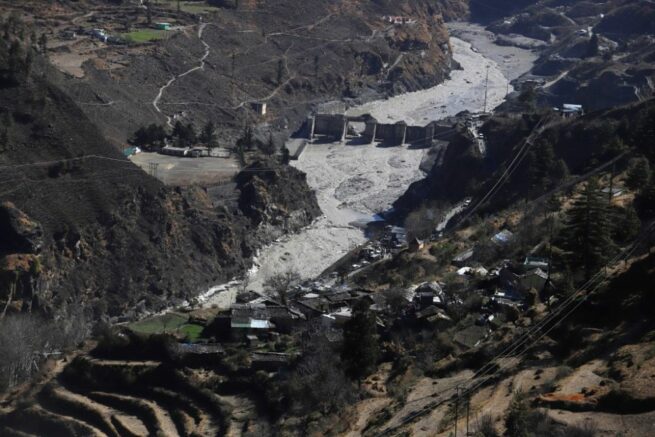People of Uttarakhand, India, on the other side of the Himalayas, have been devastated: the huge floods washed down the hydropower dam, almost razed a downstream settlement, 13 villages along the way to the Sino-India border.
All road traffic was interrupted. Strangely, many local disaster victims do not want to believe that this is a “natural disaster” caused by glacier fractures, but prefer to believe that it is a “man-made disaster” jointly created by the United States and India.
According to the BBC on the 21st, the Central Intelligence Agency (CIA) about half a century ago tried to install “nuclear devices” to monitor the progress of China’s atomic bomb research and development through the favorable terrain of the Himalayas, but it has buried major hidden dangers in the Indian mountains in a series of failed attempts, which has so far made local people. The crowd is frightened.
“The nuclear device explodes?”
According to the Indian Express on the 20th, as of the 19th, at least 62 people were killed and 142 people were unaccounted for by the sudden flood in the Chamory region of Uttarakhand Pradesh, India.
Through satellite imaging and related meteorological data, meteorologists generally believe that the flood was caused by the breakup of glaciers in the Himalayan mountains, which led to the collapse of the “glacial lake”, and the deep cause behind it seems to be related to global warming.
However, the people in the disaster area do not seem to buy this explanation, and many people firmly believe that this is an “explosion” of the “nuclear device” buried in the local mountainous area. In the village of Rini, where the disaster was most serious, the village head Lavat questioned: “How can the glacier fall off in the winter? We think it may be those devices that have had an impact. The Indian government should step in to investigate and find out where those devices are located.
Many villagers in nearby villages also reported to the Times of India that they smelled “extremely stimulating smells” on the day of the flood. Villager Devi said: “This smell is so strong that people can hardly breathe.
If it’s just building debris and snow, it’s definitely not this smell. The older generation in the village told us that there was a long-lost radioactive material buried in the mountain, which may be the cause of the disaster.
The United States and India jointly launched espionage activities against China.
According to the BBC, the “nuclear device” mentioned by the disaster victims is a set of nuclear weapons monitoring equipment, which involves a high-risk and secret espionage activity carried out by the United States against China in the 1960s. In 1964, China’s atomic bomb research achieved great success, which shocked the West deeply.
The U.S. CIA quickly contacted Indian authorities to try to install surveillance equipment on the second highest peak in India, the Himalayas, Nandadvi Peak, to spy on the scientific progress of China’s nuclear weapons.
According to the report, from 1965 to 1967, the U.S. government carried out this unusual espionage against China three times, and each time with the assistance of India.
In several attempts, the CIA hired a professional mountaineering team and offered a high salary of $1,000 a month. In order to avoid suspicion, the American mountaineering team disguised itself as a scientific expedition in the spy mission, claiming to study the impact of the hypoxic environment on the body; the members also applied special “black breasts” to make the skin look like the locals. Before the mission, the team members received CIA’s “expedited training for nuclear espionage”, but it is said that they often get together to play volleyball together and get drunk during the training.
In its first mission, the mountaineering team carried a nuclear-powered monitoring equipment weighing 57 kilograms, including antenna, power supply, two sets of radio equipment, and seven plutonium capsules.
Affected by the blizzard, the summit of Nanda Devi Peak failed. Worse still, the mountaineering team wanted to leave the whole set of monitoring equipment on the mountain at that time, and recovered it to the peak next spring. However, it did not want the whole set of equipment but lost it in the snowstorm, and its whereabouts are still unknown. In subsequent attempts, the mountaineering team failed to achieve the original goal, and finally only installed another set of monitoring equipment on Mount Nandagode at a lower altitude.
“Blindly following the CIA”, India has consequences for itself.
The operation was not “decrypted” until the late 1970s. In April 1978, then Indian Prime Minister Desai launched the “blockbuster” in Parliament, but did not disclose the results of the operation.
The exposure caused security concerns. The U.S. Embassy in New Delhi was surrounded by protesters, and the slogans said, “CIA Get Out of India” and “CIA poisoned our water sources”.
According to the Times of India, the then government “blindly followed” the CIA in the espionage operation, and the latter concealed the truth from India after the loss of the plutonium capsule, and then changed its statement many times.
Since the 1970s, the Indian authorities have organized a “nuclear monitoring” locally every ten years to check whether there are abnormal radiation indicators, but the lost equipment has never been found. Until 2018, the tourism sector in Uttarakhand was calling on Modi government to continue the search.
According to The Times of India, the “life of the nuclear equipment lost by the mountaineering team is about 100 years, and it still has a service life of about 40 years.
Experts explain that its outer temperature is very high, which melts ice and snow and sinks all the time, and may cause radiation to the water source and the surrounding environment.
To be sure, as long as this “time bomb” cannot be found, it will always plague the local Indian community. However, when the American climbers talked about this matter, they had a no-to-do attitude: “God knows what impact it will have.”



